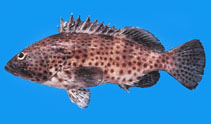| Family: |
Epinephelidae (Groupers) |
| Max. size: |
114 cm TL (male/unsexed); max.weight: 22 kg |
| Environment: |
reef-associated; marine; depth range - 50 m |
| Distribution: |
Eastern Pacific: southern California in the USA to Peru, including Revillagigedo, Clipperton and the Galapagos islands. It is the most abundant small grouper in the northern Gulf of California. |
| Diagnosis: |
Dorsal spines (total): 10-10; Dorsal soft rays (total): 16-18; Anal spines: 3-3; Anal soft rays: 8-8. Distinguished by the following characteristics: generally pale reddish brown covered with numerous dark brown spots; 5 faint oblique dark bars on body; body depth less than head length, 2.6-3.0 times in SL; head length 2.3-2.5 times in SL; shallow notch above the angle of preopercle, serrae at angle slightly enlarged; slightly convex upper edge of operculum; subequal posterior and anterior nostrils; pelvic fins shorter than pectoral fins and their origin below or behind lower end of pectoral fin base; rounded caudal fin; ctenoid midlateral-body scales, with numerous auxiliary scales (Ref. 089707). |
| Biology: |
Abundant in patch reefs where it is readily caught by anglers. Inhabits depths of at least 50 m (Ref. 089707). Feeds mainly on crustaceans and fishes on rocky and sandy bottoms. During winter, it moves closer to the shore where it feeds heavily on swarms of pelagic red crab Pleuroncodes planipes. |
| IUCN Red List Status: |
Least Concern (LC); Date assessed: 09 December 2016 Ref. (130435)
|
| Threat to humans: |
harmless |
Source and more info: www.fishbase.org. For personal, classroom, and other internal use only. Not for publication.
